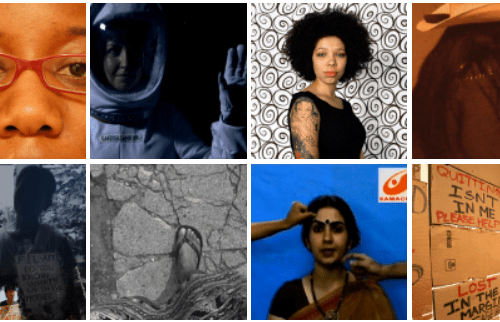Take the example of racism. It can be willful even to name racism: as if the talk about divisions is what is divisive. Given that racism recedes from social consciousness, it appears as if the ones who “bring it up” are bringing it into existence. We learned that the very talk of racism is experienced as an intrusion from the figure of the angry black woman: as if it is her anger about racism that causes feminist estrangement. To recede is to go back or withdraw. To concede is to give way, to yield. People of color are often asked to concede to the recession of racism: we are asked to “give way” by letting it “go back.” Not only that: more than that. We are often asked to embody a commitment to diversity. We are asked to smile in their brochures. The smile of diversity is a way of not allowing racism to surface; it is a form of political recession.
Racism is very difficult to talk about as racism can operate to censor the very evidence of its existence. Those who talk about racism are thus heard as creating rather than describing a problem. The stakes are indeed very high: to talk about racism is to occupy a space that is saturated with tension. History is saturation. One of the findings of a research project I was involved with on diversity was that because racism saturates everyday and institutional spaces, people of color often make strategic decisions not to use the language of racism.1 If you already pose a problem, or appear “out of place” in the institutions of whiteness, there can be “good reasons” not to exercise what is heard as a threatening vocabulary.2 Not speaking about racism can be a way of inhabiting the spaces of racism. You minimize the threat you already are by softening your language and appearance, by keeping as much distance as you can from the figure of the angry person of color. Of course, as we know, just to walk into a room can be to lose that distance, because that figure gets there before you do.
When you use the very language of racism you are heard as “going on about it,” as “not letting it go.” It is as if talking about racism is what keeps it going. Racism thus often enters contemporary forms of representation as a representation of a past experience. Take the film Bend it Like Beckham (2002, dir. Gurinder Chada): the film is very much premised on the freedom to be happy, as the freedom of the daughter, Jesminder, to do whatever makes her happy (in her case playing football—her idea of happiness is what puts her in proximity to a national idea of happiness). Her father’s memory of racism gets in the way of her happiness. Consider two speeches he makes in the film, the first one takes place early on, and the latter at the end:
When I was a teenager in Nairobi, I was the best fast bowler in our school. Our team even won the East African cup. But when I came to this country, nothing. And these bloody gora in the club house made fun of my turban and sent me off packing… She will only end up disappointed like me.
When those bloody English cricket players threw me out of their club like a dog, I never complained. On the contrary, I vowed that I would never play again. Who suffered? Me. But I don’t want Jess to suffer. I don’t want her to make the same mistakes her father made, accepting life, accepting situations. I want her to fight. And I want her to win.
In the first speech, the father says she should not play in order not to suffer like him. In the second, he says she should play in order not to suffer like him. The desire implicit in both speech acts is the avoidance of the daughter’s suffering, which is expressed in terms of the desire that she does not repeat his own. The second speech suggests that the refusal to play a national game is the “truth” behind the migrant’s suffering: you suffer because you do not play the game, where not playing is read as self-exclusion. To let Jess be happy he lets her go. By implication, not only is he letting her go, he is also letting go of his own suffering, the unhappiness caused by accepting racism, as the “point” of his exclusion.
I would suggest that the father is represented in the first speech as melancholic: as refusing to let go of his suffering, as incorporating the very object of own loss. His refusal to let Jess go is readable as a symptom of melancholia: as a stubborn attachment to his own injury.3 As he says: “who suffered? Me.” Bad feeling thus originates with the migrant who won’t let go of racism as a script that explains suffering. The melancholic migrant holds onto the unhappy objects of difference, such as the turban, or at least the memory of being teased about the turban, as that which ties it to a history of racism. It is as if you should let go of the pain of racism by letting go of racism as a way of remembering that pain. I would even say that racism becomes readable as what the melancholic migrant is attached to, as an attachment to injury that allows migrants to justify their refusal to participate in the national game (“the gora in their club house”). Even to recall an experience of racism, or to describe an experience as racism, can be to get in the way of the happiness of others.
Consciousness of racism becomes understood as a kind of false consciousness, as consciousness of that which is no longer. Racism is framed as a memory that if it were kept alive would just leave us exhausted. The task of citizenship becomes one of conversion: if racism is preserved only in our memory and consciousness, then racism would “go away” if only we too would declare it gone. The narrative implicit here is not that we “invent racism,” but that we preserve its power to govern social life by not getting over it. The moral task is thus “to get over it,” as if when you are over it, it is gone.
- Sara Ahmed, Shona Hunter, Sevgi Kilic, Elaine Swan, and Lewis Turner, “Race, Diversity and Leadership in the Learning and Skills Sector,” (PDF) Unpublished Report, 2006. [↩]
- Nirmal Puwar, Space Invaders: Race, Gender and “Bodies out of Place” (Oxford: Berg, 2004). [↩]
- For excellent discussions of racial melancholia see: Anne-Anlin Cheng, The Melancholia of Race: Psychoanalysis, Assimilation and Hidden Grief (Oxford: Oxford University Press, 2001); and David L. Eng and Shinhee Han, “A Dialogue on Racial Melancholia,” in David L. Eng and David Kazanjian (eds.) Loss: The Politics of Mourning (Berkeley: University of California Press, 2003) 343-371. [↩]




